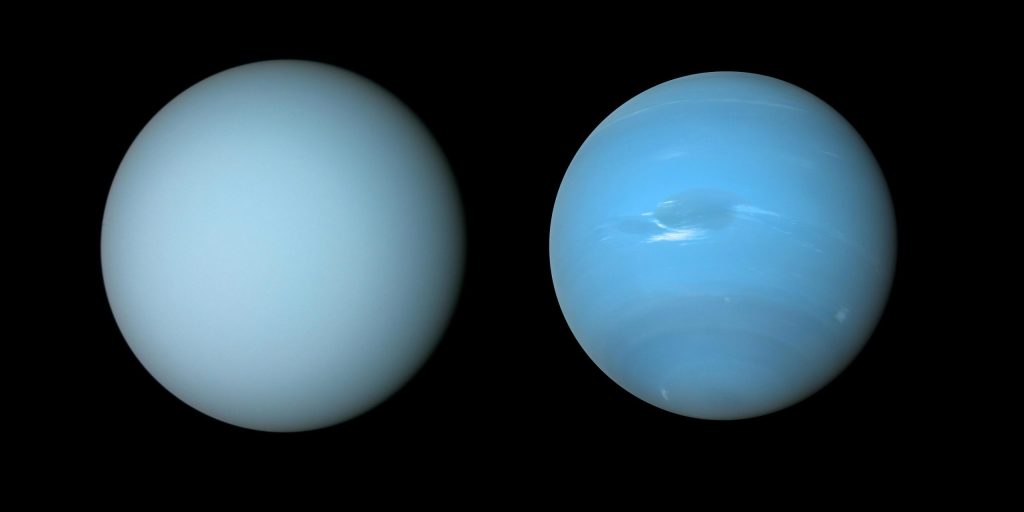
A NASA Voyager 2 űrszondája az 1980-as években a bolygók átrepülése során rögzítette az Uránusz (balra) és a Neptunusz (jobb oldali) képeit. Köszönetnyilvánítás: NASA/JPL-Caltech/B. Johnson
A Gemini Obszervatórium és más távcsövek megfigyelései túlzott homályosságot mutatnak[{” attribute=””>Uranus makes it paler than Neptune.
Astronomers may now understand why the similar planets Uranus and Neptune have distinctive hues. Researchers constructed a single atmospheric model that matches observations of both planets using observations from the Gemini North telescope, the NASA Infrared Telescope Facility, and the Hubble Space Telescope. The model reveals that excess haze on Uranus accumulates in the planet’s stagnant, sluggish atmosphere, giving it a lighter hue than Neptune.
A Neptunusz és az Uránusz bolygókban sok a közös – hasonló tömegük, méretük és légköri összetételük –, megjelenésük azonban jelentősen eltér egymástól. A látható hullámhosszokon a Neptunusz láthatóan kékebb színű, míg az Uránusz halványabb cián árnyalatú. A csillagászoknak most van magyarázata arra, hogy miért olyan eltérő a két bolygó színe.
Az új kutatások azt mutatják, hogy a koncentrált ködréteg mindkét bolygón vastagabb az Uránuszon, mint egy hasonló réteg a Neptunuszon, és jobban „fehéríti” az Uránusz megjelenését, mint a Neptunuszon.[1] Ha nincs köd benne hangulatot A Neptunuszból és az Uránuszból mindkettő nagyjából egyforma kék színben jelenik meg.[2]
Ez a következtetés egy modellből származik[3] hogy Patrick Irwin, az Oxfordi Egyetem bolygófizikai professzora vezette nemzetközi csapat a Neptunusz és az Uránusz légkörében lévő aeroszolrétegek leírására dolgozott ki.[4] A bolygók felső légkörének korábbi vizsgálatai csak a légkör meghatározott hullámhosszokon való megjelenésére összpontosítottak. Ez az új modell azonban, amely több légköri rétegből áll, mindkét bolygó megfigyeléseit a hullámhosszok széles tartományában egyezteti. Az új modellben olyan mélyebb rétegekben is találhatóak homályos részecskék, amelyekről korábban azt hitték, hogy csak metán- és hidrogén-szulfid-jeget tartalmaznak.

Ez a diagram három aeroszolréteget mutat be az Uránusz és a Neptunusz légkörében, amelyeket Patrick Irwin vezette tudóscsoport tervezett. A grafikonon lévő magasságmérő a 10 bar feletti nyomást mutatja.
A legmélyebb réteg (aeroszol réteg-1) vastag, és hidrogén-szulfid jég keverékéből és a bolygó légkörének napfénnyel való kölcsönhatásából származó részecskék keverékéből áll.
A színeket befolyásoló fő réteg a középső réteg, amely ködrészecskékből álló réteg (a papírban aeroszolréteg-2-nek nevezik), amely vastagabb az Uránuszon, mint a Neptunuszon. A csapat azt gyanítja, hogy mindkét bolygón metánjég kondenzálódik a réteg részecskéin, és a metánhó hullásával a részecskéket mélyebbre vonja a légkörbe. Mivel a Neptunusz légköre aktívabb és turbulensebb, mint az Uránuszé, a csapat úgy véli, hogy a Neptunusz légköre hatékonyabban tudja a metánrészecskéket a ködrétegbe tolatni, és havat termelni. Ez több ködöt távolít el, és vékonyabbá teszi a Neptunusz ködrétegét, mint az Uránuszon, ami azt jelenti, hogy a Neptunusz kékje erősebbnek tűnik.
Mindkét réteg felett egy kiterjesztett ködréteg (3. aeroszolréteg) található, amely hasonló az alatta lévőhöz, de törékenyebb. A Neptunuszon e réteg felett is nagy metánjégrészecskék képződnek.
Köszönetnyilvánítás: Gemini International Observatory/NOIRLab/NSF/AURA, J. da Silva/NASA/JPL-Caltech/B. Johnson
„Ez az első olyan modell, amely szinkronban illeszkedik az ultraibolya és a közeli infravörös közötti visszavert napfény megfigyeléséhez” – magyarázta Irwin, a Journal of Geophysical Research: Planets című folyóiratban ezt az eredményt bemutató kutatási cikk vezető szerzője. „Ő az első, aki megmagyarázza az Uránusz és a Neptunusz látható színének különbségét.”
A csapat modellje három különböző magasságú aeroszolrétegből áll.[5] A színeket befolyásoló fő réteg a középső réteg, amely ködrészecskékből álló réteg (a papíron aeroszolréteg-2-nek nevezik), amely vastagabb a felület felett. Uránusz A Neptun. A csapat azt gyanítja, hogy mindkét bolygón metánjég kondenzálódik a réteg részecskéin, és a metánhó hullásával a részecskéket mélyebbre vonja a légkörbe. Mivel a Neptunusz légköre aktívabb és turbulensebb, mint az Uránuszé, a csapat úgy véli, hogy a Neptunusz légköre hatékonyabban tudja a metánrészecskéket a ködrétegbe tolatni, és havat termelni. Ez több ködöt távolít el, és vékonyabbá teszi a Neptunusz ködrétegét, mint az Uránuszon, ami azt jelenti, hogy a Neptunusz kékje erősebbnek tűnik.
Mike Wong, a csillagász a[{” attribute=””>University of California, Berkeley, and a member of the team behind this result. “Explaining the difference in color between Uranus and Neptune was an unexpected bonus!”
To create this model, Irwin’s team analyzed a set of observations of the planets encompassing ultraviolet, visible, and near-infrared wavelengths (from 0.3 to 2.5 micrometers) taken with the Near-Infrared Integral Field Spectrometer (NIFS) on the Gemini North telescope near the summit of Maunakea in Hawai‘i — which is part of the international Gemini Observatory, a Program of NSF’s NOIRLab — as well as archival data from the NASA Infrared Telescope Facility, also located in Hawai‘i, and the NASA/ESA Hubble Space Telescope.
The NIFS instrument on Gemini North was particularly important to this result as it is able to provide spectra — measurements of how bright an object is at different wavelengths — for every point in its field of view. This provided the team with detailed measurements of how reflective both planets’ atmospheres are across both the full disk of the planet and across a range of near-infrared wavelengths.
“The Gemini observatories continue to deliver new insights into the nature of our planetary neighbors,” said Martin Still, Gemini Program Officer at the National Science Foundation. “In this experiment, Gemini North provided a component within a suite of ground- and space-based facilities critical to the detection and characterization of atmospheric hazes.”
The model also helps explain the dark spots that are occasionally visible on Neptune and less commonly detected on Uranus. While astronomers were already aware of the presence of dark spots in the atmospheres of both planets, they didn’t know which aerosol layer was causing these dark spots or why the aerosols at those layers were less reflective. The team’s research sheds light on these questions by showing that a darkening of the deepest layer of their model would produce dark spots similar to those seen on Neptune and perhaps Uranus.
Notes
- This whitening effect is similar to how clouds in exoplanet atmospheres dull or ‘flatten’ features in the spectra of exoplanets.
- The red colors of the sunlight scattered from the haze and air molecules are more absorbed by methane molecules in the atmosphere of the planets. This process — referred to as Rayleigh scattering — is what makes skies blue here on Earth (though in Earth’s atmosphere sunlight is mostly scattered by nitrogen molecules rather than hydrogen molecules). Rayleigh scattering occurs predominantly at shorter, bluer wavelengths.
- An aerosol is a suspension of fine droplets or particles in a gas. Common examples on Earth include mist, soot, smoke, and fog. On Neptune and Uranus, particles produced by sunlight interacting with elements in the atmosphere (photochemical reactions) are responsible for aerosol hazes in these planets’ atmospheres.
- A scientific model is a computational tool used by scientists to test predictions about a phenomena that would be impossible to do in the real world.
- The deepest layer (referred to in the paper as the Aerosol-1 layer) is thick and is composed of a mixture of hydrogen sulfide ice and particles produced by the interaction of the planets’ atmospheres with sunlight. The top layer is an extended layer of haze (the Aerosol-3 layer) similar to the middle layer but more tenuous. On Neptune, large methane ice particles also form above this layer.
More information
This research was presented in the paper “Hazy blue worlds: A holistic aerosol model for Uranus and Neptune, including Dark Spots” to appear in the Journal of Geophysical Research: Planets.
The team is composed of P.G.J. Irwin (Department of Physics, University of Oxford, UK), N.A. Teanby (School of Earth Sciences, University of Bristol, UK), L.N. Fletcher (School of Physics & Astronomy, University of Leicester, UK), D. Toledo (Instituto Nacional de Tecnica Aeroespacial, Spain), G.S. Orton (Jet Propulsion Laboratory, California Institute of Technology, USA), M.H. Wong (Center for Integrative Planetary Science, University of California, Berkeley, USA), M.T. Roman (School of Physics & Astronomy, University of Leicester, UK), S. Perez-Hoyos (University of the Basque Country, Spain), A. James (Department of Physics, University of Oxford, UK), J. Dobinson (Department of Physics, University of Oxford, UK).
NSF’s NOIRLab (National Optical-Infrared Astronomy Research Laboratory), the US center for ground-based optical-infrared astronomy, operates the international Gemini Observatory (a facility of NSF, NRC–Canada, ANID–Chile, MCTIC–Brazil, MINCyT–Argentina, and KASI–Republic of Korea), Kitt Peak National Observatory (KPNO), Cerro Tololo Inter-American Observatory (CTIO), the Community Science and Data Center (CSDC), and Vera C. Rubin Observatory (operated in cooperation with the Department of Energy’s SLAC National Accelerator Laboratory). It is managed by the Association of Universities for Research in Astronomy (AURA) under a cooperative agreement with NSF and is headquartered in Tucson, Arizona. The astronomical community is honored to have the opportunity to conduct astronomical research on Iolkam Du’ag (Kitt Peak) in Arizona, on Maunakea in Hawai‘i, and on Cerro Tololo and Cerro Pachón in Chile. We recognize and acknowledge the very significant cultural role and reverence that these sites have for the Tohono O’odham Nation, the Native Hawaiian community, and the local communities in Chile, respectively.

„Utazási specialista. Tipikus közösségi média tudós. Az állatok barátja mindenhol. Szabadúszó zombinindzsa. Twitter-barát.”



:max_bytes(150000):strip_icc():focal(730x203:732x205)/Coco-Gauff-LeBron-James-072624-tout-295c52be85f74bb18236bca7dc254e80.jpg)
/cdn.vox-cdn.com/uploads/chorus_asset/file/25546355/intel_13900k_tomwarren__2_.jpg)
More Stories
A csillagászok felfedezik a valaha volt legfényesebb gamma-kitörés első emissziós spektrumát
Szeretnél úgy főzni, mint egy neandervölgyi? A régészek titkokat fedeznek fel
A „sötét oxigén” felfedezése felforgathatja a földi életről alkotott képünket